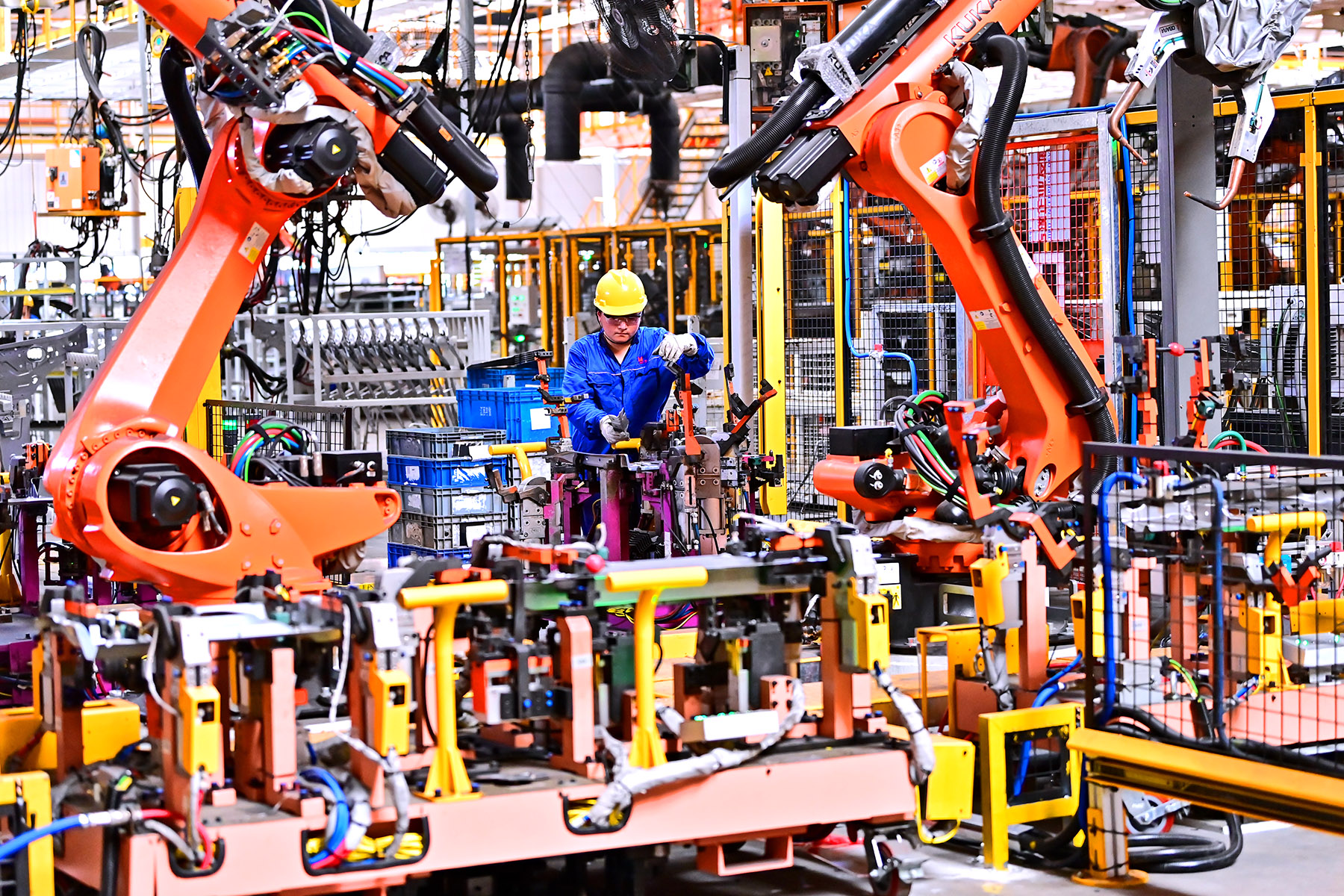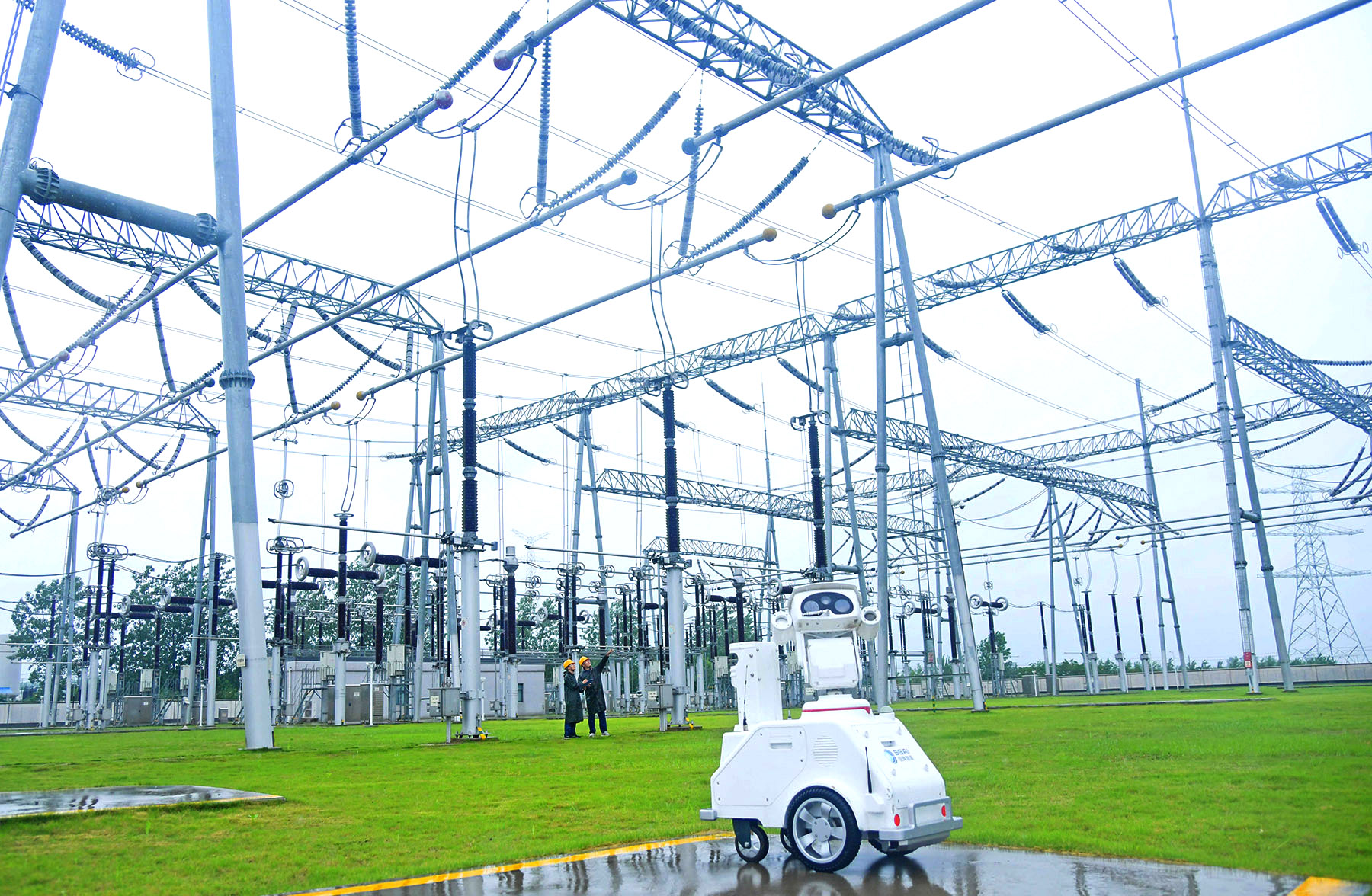Improved solution provides a glimpse of even-faster 6G; to drive industrial transformation with AI for better connectivity and more innovation

As China celebrates the sixth anniversary of 5G commercialization, the fusion of artificial intelligence with next-generation connectivity is unlocking unprecedented industrial transformation, which is of crucial importance to the upgrade of the country's sprawling industrial economy, corporate executives and experts said.
What began as a high-speed network blueprint has now evolved into a dynamic ecosystem where 5G-Advanced, or 5G-A, technology bridges today's smart applications and tomorrow's 6G ambitions — with China at the forefront of this global shift, they added.
Globally, 5G has achieved staggering adoption, surpassing 2 billion connections by 2024 — half of which are in China, the first market to hit 1 billion 5G users, according to a report from the GSMA, an industry group representing the world's largest mobile phone operators.
READ MORE: China plans further push to speed up innovation in telecom, internet sectors
By 2030, 5G is projected to comprise 57 percent of total mobile connections globally, with China's robust network laying the foundation for industrial digitization, the GSMA said.
Yet, like a vast highway system needing traffic control, 5G's potential hinges on intelligent orchestration. Enter AI: generative models and machine learning are becoming 5G's "digital brain," optimizing everything from factory floors to low-altitude drones, experts added.
In real-world applications, this synergy has taken center stage. Humanoid robots perform precision tasks, autonomous taxis navigate urban grids, and AI devices redefine human-machine interaction — all powered by 5G-A's low latency and AI's real-time decision-making.
He Biao, general manager of China Mobile, said, the company "will trial 6G technologies on its 5G-A infrastructure, and promote the integrated research and development of the two".
As an important upgrade of 5G, 5G-A networks theoretically deliver tenfold improvements in peak data rates and connection density compared to 5G.
More importantly, 5G-A base stations have integrated sensing and communication capabilities. They not only handle voice and data transmission, but also can function as distributed radar systems, enabling real-time detection of airborne objects within their coverage zones, China Mobile said, adding that it is testing such a system to facilitate the development of the low-altitude economy, such as drone delivery in Shenzhen, Guangdong province.
As a global pioneer in commercializing 5G-A technology, which plays a key role in bridging 5G to 6G, China has already deployed such networks in over 300 cities, according to the Ministry of Industry and Information Technology (MIIT).
Meanwhile, more than 30 provincial-level regions in China have launched 5G-A service packages, with subscribers surpassing 10 million.
The progress came after China solidified its global leadership in 5G deployment, with the total number of 5G base stations reaching 4.44 million, achieving full 5G coverage in all townships and 90 percent penetration in administrative villages, according to the latest data disclosed by the MIIT in June.
China's 5G applications now span 86 out of 97 national economic sectors, with over 138,000 real-world use cases. Key sectors such as manufacturing, healthcare, and energy are rapidly digitizing, supported by more than 18,500 "5G + industrial internet" projects nationwide, the MIIT said.

While 5G matures, its enhanced sibling, 5G-A, coupled with AI, is also reshaping industries. In the industrial sector, 5G-A's ultra-low latency and high bandwidth are enabling precise perception and decision-making for robots. Real-time data processing via 5G-A supports closed-loop "sense-decide-act "operations, reducing high-risk work hazards while boosting efficiency and safety, according to Huawei Technologies Co.
For robots to truly integrate into industrial production and everyday applications, low latency is the basic requirement, and collaborative decision-making is the key to commercial applications, said Chang Lin, CEO of Leju Robotics.
With the help of sound networks, AI is also helping companies boost efficiency. State Grid Zhejiang Electric Power Co Ltd's information and communication branch recently unveiled its self-developed "CoolGood" AI code review agent, providing an innovative solution to a critical industry challenge. Facing the inefficiency of traditional manual "bug hunting" code reviews, the company has now achieved "near real-time diagnosis" of system code through AI. This breakthrough has doubled the efficiency of electricity billing calculations and increased the operational efficiency of core power grid business systems by a factor of ten.
Ye Wei, code review lead at the company, emphasized the critical importance of code quality: "If we compare the digital system to the neural network supporting the physical grid infrastructure, code is the neuron. Its quality directly impacts the safety, stability, and operational efficiency of the entire power grid."
However, the company faced immense pressure reviewing billions of lines of code — a daunting task akin to "finding a needle in a haystack".
Challenges included insufficient technical expertise, a shortage of skilled personnel, and the sheer volume of code, which led to a critical impasse: code reviews were often "unclear, unmanageable, and unfinishable". This bottleneck resulted in high system resource consumption, slow business response times, and poor user experience.
The key to breaking this deadlock was the deep empowerment provided by the Guangming Power Large Model. This industry-specific large model, developed by State Grid Corp of China and featuring 100 billion parameters, integrates foundational capabilities from models like DeepSeek. Utilizing "incremental pre-training plus industry fine-tuning", it has fundamentally transformed code review from labor-intensive "manual faultfinding" to efficient "AI-powered intelligent diagnosis".
This "super brain" now provides robust support for the secure operation of the power grid, the integration of renewable energy sources, and the continuous improvement of power supply services. "The 'Cool-Good' agent represents a significant leap forward in leveraging AI to ensure the reliability and efficiency of critical national energy infrastructure," Ye said.
The synergy between 5G-A's wide coverage and AI route optimization is also enhancing efficiency and cutting costs. In autonomous driving, 5G-A's sub-meter positioning merges with satellite navigation to enable cm-level vehicle precision — critical for parking and highway autonomy, Huawei said.
These innovations aren't just incremental. They are laying 6G's groundwork. Features like AI-native networks and space-terrestrial integration mirror 6G's vision of ubiquitous, self-optimizing connectivity, experts added.
Xu Zhijun, rotating chairman of Huawei, said the telecom market has entered a mature phase, yet change is omnipresent. By identifying shifts and capturing growth-driven demand, the industry can fuel further expansion.

Xu said more efforts can be made to boost the supply and consumption of high-definition videos through coordinated efforts across the entire ecosystem, and to bring 5G to every car for new growth in intelligent connected vehicles.
According to a forecast by the China Industry Innovation Alliance for the Intelligent and Connected Vehicles, 5G-connected vehicles will account for 30 percent of all cars sold in China in 2025, with penetration expected to rise steadily to 95 percent between 2026 and 2030.
Xu said autonomous vehicles must be capable of independent perception and decision-making during self-driving operations. While both the vehicle cabin and the car itself require network connectivity, their needs differ, as do their business models. Therefore, these systems should operate independently, each maintaining its own connection.
"The industry must seize this growth opportunity in intelligent connected vehicles," Xu added.
According to Huawei, commercially, experience-driven monetization is key to 5G-A's success. By translating network capabilities into premium user experiences — such as cloud gaming and multi-angle sports streaming — 5G-A enables innovative payment models. This "pay-for-experience" trend is reshaping consumption and unlocking new value.
But challenges still exist. Wu Hequan, an academician of the Chinese Academy of Engineering, said that in recent years, emerging applications such as augmented reality and the low-altitude economy have created growing demand for high uplink bandwidth. However, current 5G networks face shortcomings in insufficient uplink speeds.
According to Wu, while China's mobile networks have achieved remarkable progress in downlink speeds — with 5G being seven times faster than 4G and 5G-A 10 times faster than 5G — the uplink speeds still significantly lag behind downlink performance.
Vivek Badrinath, director-general of GSMA, said the past year has seen major strides in 5G and AI worldwide. Moving forward, GSMA will deepen collaboration with Chinese telecom carriers to seize 5G-A's opportunities in enhanced performance and system efficiency to scale AI in manufacturing, ports and beyond.
ALSO READ: Ministry: China home to 4.4m 5G base stations
The economic impact is staggering. GSMA forecasts 5G and 5G-A will generate $1 trillion in value by 2030. In China, early adopters like China Telecom showcase the potential. Their 5G-AI-satellite hybrid networks now support more than 200 low-altitude economy projects, from drone logistics to emergency response.
Yang Jie, chairman of China Mobile, the world's largest telecom carrier, highlighted the dawn of the "AI plus era", in which AI outperforms humans in tasks like image recognition and complex reasoning.
"Silicon-based lifeforms, such as AI devices, connected vehicles and robots, will soon outnumber humans," Yang said. "AI presents unprecedented opportunities. China Mobile aims to be a provider, aggregator and operator in this new era," he added.
As AI breathes life into 5G and 5G-A accelerates toward 6G, China's blueprint offers a global case study. True innovation thrives when connectivity and intelligence converge — not just in labs, but in the lived realities of factories, skies, and cities. At this crossroads, the next decade of digital transformation is being written, experts added.
Contact the writer at masi@chinadaily.com.cn


